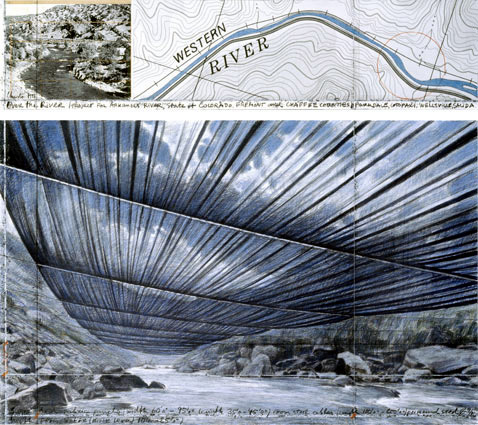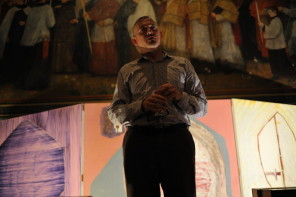 This past week, the New York Times ran an article on Christo’s most recently proposed work “Over the River,” in particular, the stir it has caused with the Bureau of Land Management. Recently, the bureau “issued what may be the first ever draft environmental impact statement purely about art” in relation to the project. Christo, famous for draping fabric over all sorts of land forms, including a curtain across the Rifle Gap in the Colorado Rockies and 6.5 million square feet of hot pink fabric around 11 islands in Biscayne Bay near Miami, has recently proposed a project which will cover 42 miles of the Arkansas River with fabric panels.
This past week, the New York Times ran an article on Christo’s most recently proposed work “Over the River,” in particular, the stir it has caused with the Bureau of Land Management. Recently, the bureau “issued what may be the first ever draft environmental impact statement purely about art” in relation to the project. Christo, famous for draping fabric over all sorts of land forms, including a curtain across the Rifle Gap in the Colorado Rockies and 6.5 million square feet of hot pink fabric around 11 islands in Biscayne Bay near Miami, has recently proposed a project which will cover 42 miles of the Arkansas River with fabric panels.
Christo is known for his bold statements and large artistic projects that stir environmental concern, however this one seems to beat them all. The article cites the importance of the land and ecosystem on which Christo wants to build: “The deep-cut gorges and canyons of the Arkansas River where Christo hopes to build the project speak to the deep time processes of geology and creation. The area is also a key habitat for bighorn sheep, raptor and fish.” While the article does not mention Christo’s specific views on the natural habitat he may be disrupting, he is quoted as saying he intended this stir in the bureau and among audiences as “part of the artistic vision itself “(and has, in fact, wished for an environmental impact statement from the bureau for years.) Wanting to cause a stir and having no concern for the environment (as many critics accuse) are two entirely different things of course, and I’m not willing to make any judgments on Christo’s ultimate motive. This story does, however, leaves me questioning how the artist’s relationship with the land in his particular case might be construed in terms of a Christian view of artistry. In a previous post, I mentioned the connection between our view of creation and our view of art, and cited Wendell Berry as saying that how artists use their materials is directly related to their view of Creation and is, therefore, of ultimate religious significance.
 So my question: is Christo bringing harm to the environment in which he works by taking on such large scale, invasive projects, or is he actually integrating art and nature in a way that previous artists had never imagined, and actually doing something that we might understand as theologically significant? Several things come into play when I think about this question: the intention of the artist in producing the work, the audience appeal of the work (and in fact the artist—he is typically understood as the picture of the strange, and often overly pretentious, modern artist), the environmental effect of the work, and the particular materials he uses and how he uses them. I’d be interested to hear how you readers might approach this question. Can you think of anything else that might come into play when considering the theological significance of the relationship between art and the environment?
So my question: is Christo bringing harm to the environment in which he works by taking on such large scale, invasive projects, or is he actually integrating art and nature in a way that previous artists had never imagined, and actually doing something that we might understand as theologically significant? Several things come into play when I think about this question: the intention of the artist in producing the work, the audience appeal of the work (and in fact the artist—he is typically understood as the picture of the strange, and often overly pretentious, modern artist), the environmental effect of the work, and the particular materials he uses and how he uses them. I’d be interested to hear how you readers might approach this question. Can you think of anything else that might come into play when considering the theological significance of the relationship between art and the environment?
Photos:
(1) Artist’s Rendering of “Over the River Project,” from overtheriver.org
(2) Surrounded Islands, Biscayne Bay, easyart.com





Regarding the relationship between an artist and his materials, Tolkien once said, ‘Fantasy is made out of the Primary World, but a good craftsman loves his material, and has a knowledge and feeling for clay, stone and wood which only the art of making can give’ (‘On Fairy-stories’).
Assessing the theological significance of the relationship between land and artist in Christo’s work would probably also require a survey of the work to other ‘Land artists.’ Then it might be possible to get a feeling for exactly how ‘invasive’ his works actually. Personally, I have often thought of his work as actually highlighting distinctive features of the landscape (by hiding it or drawing attention to its contours) rather than actually causing harm or seriously manipulating the land. Perhaps many of his installations are more ‘invasive’ than some other artists, but has anyone actually documented a negative impact upon the environment because of one of Christo’s pieces? I would be really surprised if someone has since his ‘wrappings’ are usually (maybe always?) temporary. Is there some worry about the environmental impact of the current river piece that you mentioned?
I’m afraid I’m not familiar enough with “land art” as a genre to place Christo within a spectrum of artists who impact the environment for good or ill, though it would be a really interesting project. With this particular Over the River project, it seems like the major concern is disruption of the plant and animal species that call the place their home. Several organizations have been formed (one prominent one being Rags Over the Arkansas River) that highlight these potential threats to the area and strongly protest the project. While I think many groups like that can often fail to see how humans can harmoniously live and work with the environment rather than against it, it’s interesting at least to think about the concerns they raise.
Furthermore, the fact that the Bureau of Land Management has issued an environmental impact statement (which is apparently a fairly big deal) speaks to the fact that there is at least some space for concern about such matters. I haven’t read the document in its entirety (it’s fairly long), but it does highlight the direct, indirect, and cumulative impact the project will have for the area. It seems like the actual construction of the project is what is of most concern as they have to install posts, beams, etc. with major equipment that disrupts the land around the river, affecting plant, animal, and human dwellers. Some other issues include disruption of bird migration and nesting patterns in the area and disruption of the soil which could proliferate invasive weeds.
As far as I can tell, all of Christo’s projects have been temporary, however some attention has also been drawn to the remnants of projects leftover after the project is finished. For instance, concrete beams remain in place from the Rifle Gap project in the 1980’s that are eyesores for passers by. Also, there was attention drawn to the bird, fish, and other aquatic life disrupted in the Biscayne Bay project (though I’m not sure any official scientific studies were done on this). In light of all this, it does seem like the projects might be undertaken in a different way that could help relieve some of the impact on the environment (the bureau has proposed shortening the distance of the river covered to only a few miles rather than 42, for instance).
I think one important thing Christo’s work does highlight is the basic relationship between humans and the earth. Within ecology-related discussions, there seem to be two majors schools, the one thinking that humans should leave nature alone and that any human impact is bad (and this takes all sorts of forms including protests against the cutting down of all and any trees, whether or not the species is native or not, or whether it negatively impacts the ecosystem in that area), the other being that humans can live harmoniously with the environment and that we can learn all sorts of ways to have nature be as it’s “supposed to be” (which might include cutting down some trees!) while at the same time, benefiting ourselves. I’m not sure what Christo’s particular intention is, but it seems like art in general (and land art in particular) is a really important way that this relationship between people and place could be explored. And I think that, ultimately, is something that has theological significance.
P.S. Sorry this comment is so long! 🙂
Thanks for this reply, and no need to apologize for the length (in fact, longer would have been better!). Thanks for clarifying those concerns about Christo’s projects. I did not realize that so many groups had raised concerns, and it would be interesting to know how Christo responds to these. I can certainly think of ‘land art’ projects that I would classify as more invasive than Christo’s projects that I have heard of, but there it is undeniable that what Christo does, he usually does big. I definitely agree with you that art is an important way to explore the relationship between people and place, and that this relationship has theological significance. But here is where I would like your reply to keep going. In what way or ways in this relationship ‘theologically significant’? Are you primarily thinking of humanity’s vocation to cultivate the land and to treat it as a gift? Or are there other dimensions to this significance?
Jim, Because of the extended nature of my reply and the fact that I thought it made an interesting post, my new blog is a response to your final question.
It might be useful to look at Christo and Jean-Claude’s (the collaborative husband-wife team has taken to using their more accurate and egalitarian collaborative moniker for quite a while now!) Running Fence – a twenty-four mile fence that ran from far inland to the sea in Sonoma and Marin county California in 1976. At 18 feet high, I imagine there may be some discussion of its environmental impact out there somewhere.
Also, regarding other land artists, the work of Michael Heizer in the Nevada desert, as well as in Illinois might be interesting to take a look at. I’m not sure anyone is so concerned about the Nevada desert, but his Effigy Tumuli on the banks of the Illinois river in Buffalo Rock State Park might provide some information about the environmental impact of artworks. Others would be James Turrell’s Roden Crater project in Arizona, and possibly Smithson’s Spiral Jetty. 🙂
Dayton,
Thanks for the recommendations! I’ll definitely look into those!